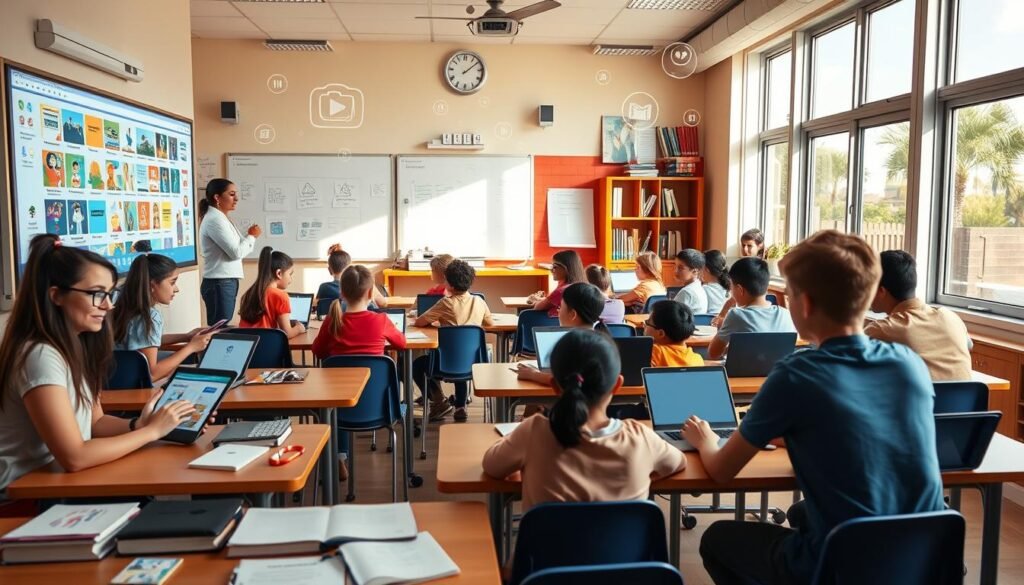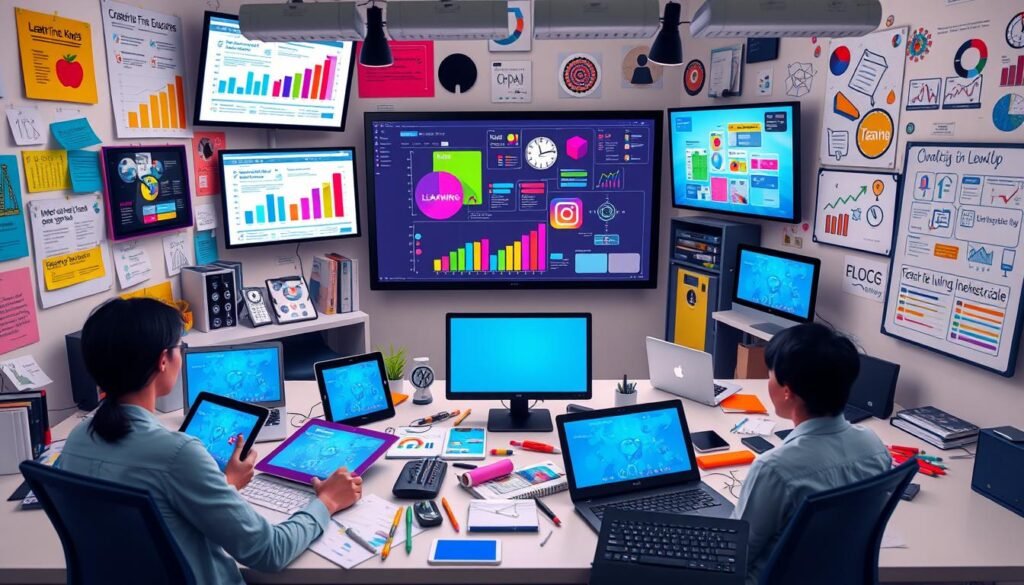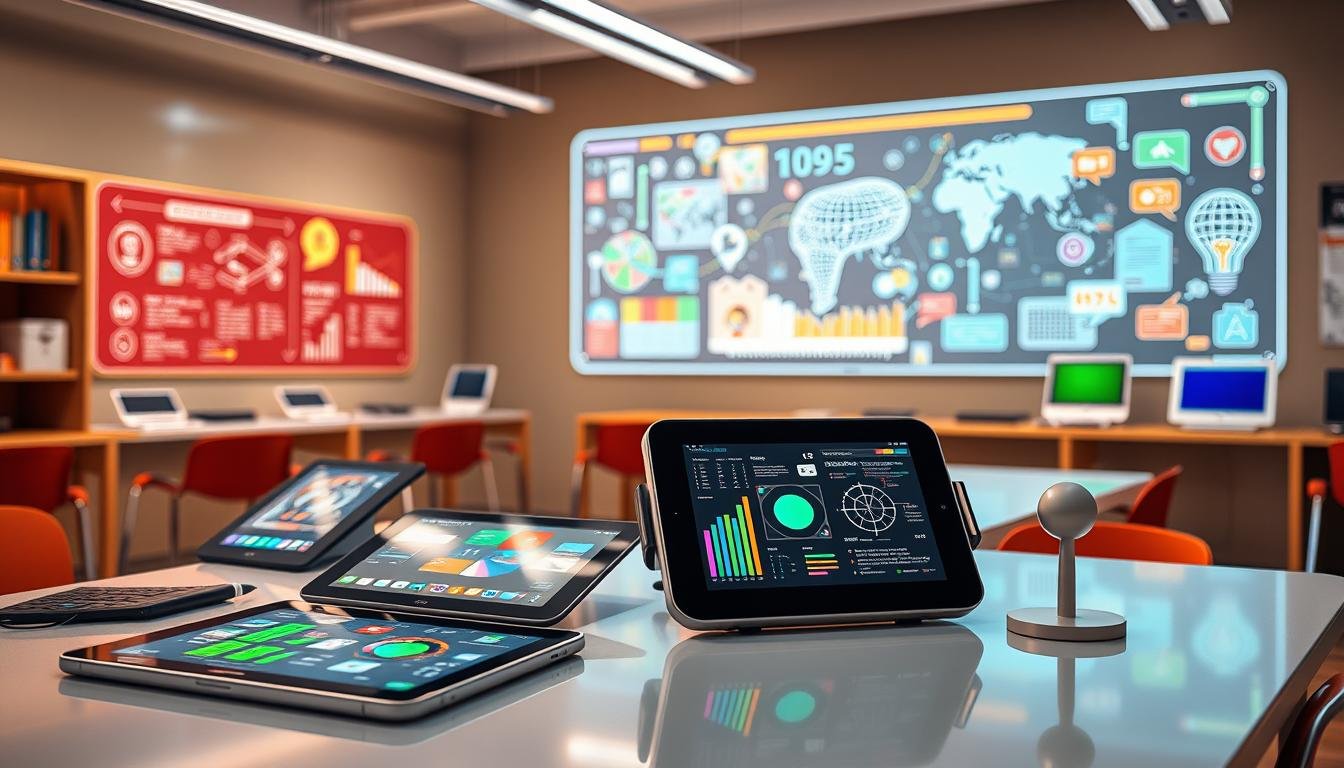Did you know that approximately 90% of educators believe that digital learning resources significantly enhance student engagement? This remarkable statistic underscores the pivotal role technology plays in shaping modern education. Educational institutions are embracing these innovative learning experiences, offering students personalized and accessible learning environments previously unimaginable. The integration of digital tools and platforms is revolutionizing how both teachers and students approach education, making learning more engaging and effective.
In this guide, we delve into the vast landscape of digital learning resources, highlighting their significance in today’s educational context. From e-learning platforms to virtual classrooms, these tools redefine our understanding of teaching and learning. As we navigate the complexities of modern education, grasping and utilizing these resources becomes crucial for educators and learners. For a deeper exploration of this evolving subject, refer to this comprehensive overview of digital literacy in education here.
Key Takeaways
- Digital learning resources are crucial in enhancing student engagement.
- These tools provide accessibility and flexibility for learners.
- Innovative learning experiences lead to improved educational outcomes.
- Understanding digital tools is essential for modern educators.
- Integration of technology transforms traditional teaching methods.
Understanding Digital Learning Resources
Digital learning resources comprise a spectrum of technologies designed to enrich educational experiences, thereby enhancing engagement and accessibility for all. The advent of technology in the educational realm has revolutionized learning paradigms, offering a plethora of formats tailored to diverse learner needs.
Definition and Examples
These resources include e-books, online courses, and interactive multimedia, among others. They provide an extensive repository of knowledge, accessible at the learner’s convenience, thereby promoting flexibility in educational pursuits. Noteworthy examples include Coursera, which collaborates with universities to deliver online courses, and Khan Academy, renowned for its comprehensive lessons across various disciplines. Such platforms exemplify the breadth of digital learning resources and their capacity to meet diverse educational preferences.
Benefits of Digital Learning
The advantages of digital learning are profound. Interactive formats significantly enhance learner engagement, surpassing traditional methods. Accessibility is another key benefit, allowing learners from diverse backgrounds to access materials at their convenience, regardless of geographical location. Personalization further empowers learners by tailoring educational experiences to their individual needs. Studies underscore these advantages of digital learning, affirming their role in boosting student success and retention rates.
The Evolution of Digital Learning
The evolution of digital learning has traversed several decades, witnessing profound transformations in technology and pedagogical approaches. This historical context offers a lens through which to understand the genesis of contemporary educational methodologies.
Historical Context
The advent of digital learning is rooted in the integration of computers into educational settings during the latter half of the 20th century. This period heralded a paradigm shift towards a more technologically-centric educational landscape. It was punctuated by pivotal milestones such as:
- The advent of the internet, which broadened the scope of accessible information.
- The emergence of learning management systems (LMS), streamlining course administration and online pedagogy.
- The proliferation of multimedia educational content, enriching the learning experience.
Recent Innovations
Recent advancements in digital learning underscore a commitment to leveraging technology to captivate learners. This includes:
- Mobile learning applications, empowering students to engage in learning anywhere, anytime.
- Gamification strategies, designed to boost motivation and engagement.
- Adaptive learning technologies, crafting personalized educational journeys.
These innovations underscore a relentless pursuit to forge interactive and impactful educational experiences for every learner.
Types of Digital Learning Resources
Digital learning resources span a broad spectrum, addressing diverse educational needs. Identifying these resources is crucial for learners and educators to choose the most appropriate options for their specific requirements.
E-learning Platforms
E-learning platforms are pivotal in delivering structured online education. They offer comprehensive course materials, assessments, and discussion forums. Platforms like Coursera and Udacity provide a wide array of programs, appealing to both students and professionals aiming to improve their skills. These platforms enable learners to navigate through content tailored to their interests and career aspirations.
Educational Apps
Educational apps have transformed learning by offering flexible mobile education opportunities. They feature interactive quizzes, video lessons, and gamified experiences. Apps like Duolingo and Khan Academy facilitate engagement with content anywhere, anytime. Their convenience and accessibility enable continuous learning, accommodating users’ hectic schedules.
Virtual Classrooms
Virtual classrooms have redefined student-teacher and peer interactions. Leveraging video conferencing, these platforms facilitate real-time discussions and collaborative learning. Tools such as Zoom and Google Classroom enhance communication, enabling educators to deliver engaging lessons. This integration into traditional education makes learning more interactive and inclusive.
Benefits of Using Digital Learning Resources
Digital learning resources offer a plethora of advantages tailored to the varied needs of learners. These cutting-edge tools significantly enhance the educational journey, rendering it both enjoyable and effective.
Flexibility and Accessibility
The flexibility in education provided by digital learning resources is unparalleled. Learners have the autonomy to study at their own pace, selecting the optimal time and location for engagement. This adaptability empowers individuals to harmonize their academic pursuits with other life commitments, thereby making education more accessible than ever before. Furthermore, the compatibility of these resources across multiple devices ensures that students can access their educational materials at any time, from anywhere.
Personalized Learning Experiences
Digital learning enables personalized learning experiences by customizing content to align with the unique requirements of each student. The ability to monitor progress and adapt to individual learning styles ensures a tailored educational experience. This personalized approach not only enhances engagement but also facilitates better outcomes by focusing on areas that require additional attention.
Key Features of Effective Digital Learning Resources
Effective digital learning resources are distinguished by specific features that significantly enhance the educational experience. Among these, user-friendly interfaces and interactive content emerge as crucial elements.
User-Friendly Interfaces
User-friendly interfaces are paramount for platforms aiming to deliver effective digital learning resources. They facilitate seamless navigation, thereby reducing learner frustration and enabling them to focus on the content. The incorporation of clear designs, intuitive layouts, and straightforward access to various sections of the resource boosts engagement and fosters a sense of comfort with the technology.
Interactive Content
The inclusion of interactive content is pivotal in enhancing student participation and retention of knowledge. Utilizing multimedia such as videos, quizzes, and simulations, these resources foster active learning. Learners benefit from immediate feedback, which prompts them to assess their comprehension and refine their study approaches. This synergy of usability and engagement transforms passive learning into an engaging and dynamic experience.
Popular Digital Learning Platforms
The surge in online education has led to the emergence of several prominent digital learning platforms. Each platform offers distinct features, catering to a wide array of learning needs. We will delve into three notable platforms: Coursera, Udemy, and Khan Academy.
Coursera
Coursera collaborates with leading universities and organizations worldwide, delivering high-caliber courses across various disciplines. It enables users to access content on par with university standards, even earning degrees or certificates. This platform is instrumental in enhancing professional competencies and fostering continuous learning.
Udemy
Udemy boasts an extensive collection of courses, catering to diverse interests. Whether it’s programming or culinary arts, learners can discover courses that align with their interests. The platform’s flexibility in course duration and format empowers students to learn at their own pace, positioning it as a highly adaptable platform.
Khan Academy
Khan Academy is dedicated to offering free educational resources, primarily for students in grades K-12. Its goal is to ensure that quality education is accessible to all, regardless of financial constraints. Through engaging videos and interactive exercises, Khan Academy supports foundational learning, aiding students as they navigate through different subjects.
How to Choose the Right Resource
Selecting the optimal digital learning resource necessitates meticulous consideration. Initially, grasping individual learning needs is paramount. Each learner’s objectives and preferences are unique, necessitating personalized resource selection. Subsequently, the evaluation of content quality emerges as a critical factor. High-quality resources foster effective learning and engagement, whereas inferior content can impede progress.
Assessing Learning Needs
When evaluating learning needs, several factors must be taken into account:
- Learning Style: Determine whether the learner is more inclined towards visual, auditory, or kinesthetic approaches.
- Goals: Clarify the learner’s objectives, whether it pertains to skill development or knowledge enhancement.
- Areas of Difficulty: Identify subjects that pose challenges, enabling the selection of resources that address these specific areas.
Evaluating Content Quality
Content quality stands as a pivotal factor in the selection of digital resources. It is prudent to:
- Verify credibility by examining the qualifications of the authors or the organizations behind the content.
- Seek out resources with regular updates to maintain relevance and timeliness.
- Consult user reviews and comparisons to assess the effectiveness and dependability of different platforms.
Integrating Digital Resources in Traditional Education

The integration of digital resources into traditional educational settings presents a plethora of opportunities to elevate the learning experience. By embracing blended learning models, educators can seamlessly merge face-to-face instruction with online components. This synergy enriches the educational journey, offering students flexibility and the autonomy to progress at their own pace. Simultaneously, it allows for the invaluable guidance of instructors, ensuring a holistic learning experience.
Blended Learning Models
Blended learning models emerge as pivotal frameworks for amalgamating classroom activities with online learning modalities. These models encompass a variety of approaches, including:
- Self-paced courses: Students have the flexibility to access materials at any time, fostering personalized learning experiences.
- Flipped classrooms: Classroom sessions are reserved for discussions and practical applications, while theoretical content is delivered digitally.
- Hybrid formats: A combination of in-person and online sessions ensures engagement and accommodates diverse learning styles.
Classroom Technology
Classroom technology is instrumental in creating a dynamic learning environment. Tools such as interactive projectors, tablets, and educational software facilitate student engagement and collaboration. These innovations enable the effective integration of digital resources into lessons, promoting a more interactive and engaging classroom atmosphere. By leveraging modern classroom technology, educators empower students to become active participants in their learning, thereby enhancing their educational outcomes.
The Role of Educators in Digital Learning
The educational landscape is undergoing a profound transformation, redefining the role of educators from traditional instructors to pivotal facilitators in digital learning environments. This shift underscores the imperative for educators to refine their pedagogical approaches to cater to the varied needs of students. It also necessitates the effective utilization of digital resources.
Facilitator vs. Instructor
In digital learning settings, the facilitator in digital learning cultivates an environment conducive to collaborative learning, where students are actively involved in their educational journey. Unlike the traditional instructor, who primarily disseminates information, the facilitator empowers students to delve into content, promoting critical thinking and self-directed learning. This transformation enables students to navigate diverse digital resources, fostering a more personalized educational experience.
Professional Development Opportunities
To excel in their new roles, educators must commit to ongoing professional development. Workshops and training sessions focused on educational technology are essential for equipping them with the skills to enhance their teaching methodologies. Programs such as professional development initiatives offer invaluable resources, empowering educators to excel in the dynamic digital educational landscape. By seizing these opportunities, educators can more effectively support their students in the digital age.
Challenges of Digital Learning Resources
Digital learning resources offer numerous benefits, yet they pose significant challenges that educators and learners must navigate. Grasping these hurdles is essential for enhancing the efficacy of digital education.
Technological Barriers
Technological barriers stand as a major obstacle in digital learning. The lack of access to devices and stable internet hampers many students. This disparity creates a chasm, where some students excel while others are left behind, unable to fully engage with digital materials. It is imperative for educational institutions and organizations to find ways to bridge this gap. They must ensure that all students have the necessary tools to thrive in a digital environment.
Engagement and Motivation Issues
Ensuring student engagement and motivation in a digital setting is a complex challenge. Virtual platforms often fail to capture the same level of engagement as traditional classrooms. Interactive elements are critical for maintaining interest, yet many resources lack these features. Educators must employ innovative strategies to create engaging content and promote active participation. This approach is vital for overcoming engagement issues and fostering a more interactive learning environment.
Future Trends in Digital Learning
The digital learning landscape is undergoing a transformative evolution, introducing groundbreaking innovations that promise to redefine education. At the forefront of this change are artificial intelligence in education and virtual reality. These advancements signify a paradigm shift towards more personalized and immersive educational experiences.
Artificial Intelligence and Learning
Artificial intelligence in education is poised to revolutionize the learning process. AI’s capability to analyze individual learning patterns and adapt content to specific needs is transformative. This personalization not only enhances engagement but also significantly improves educational outcomes. Tailored learning pathways allow students to progress at their own pace, a significant benefit in diverse classrooms.
Virtual and Augmented Reality
Virtual reality is opening up new avenues for experiential learning, moving beyond conventional methods. By immersing students in realistic environments, VR transforms abstract concepts into tangible experiences. This approach enhances knowledge retention. Augmented reality, by overlaying digital information onto the real world, offers an interactive learning experience. The synergy between virtual and augmented reality exemplifies the future of digital learning, offering unparalleled engagement and exploration opportunities.
Creating Digital Learning Resources

The development of effective digital learning resources necessitates a meticulous approach and the selection of appropriate tools. Educators and content creators must leverage a variety of tools for content creation to elevate the learning experience. It is imperative to adhere to the best practices in education, ensuring that these resources not only captivate learners but also adhere to educational benchmarks.
Tools for Content Creation
Several tools are indispensable for crafting digital learning resources. Notable among these are:
- Articulate Storyline
- Adobe Captivate
- Camtasia
- Prezi
These platforms enable the seamless integration of multimedia elements, interactive quizzes, and captivating visuals. This integration enhances the learning experience, making it both enjoyable and impactful.
Best Practices
Adopting best practices in education is paramount when creating digital learning resources. Essential strategies include:
- Incorporating diverse multimedia: Employ videos, infographics, and animations to elucidate concepts.
- Meeting accessibility standards: Guarantee that resources are accessible to all learners, including those with disabilities.
- Aligning content with learning objectives: Clearly articulate goals to guide the design and assessment of resources.
Measuring Success in Digital Learning
Understanding the impact of digital learning initiatives is crucial. Various methods are employed to measure success, with a focus on analytics and data tracking tools. These tools evaluate learner progress and engagement, offering insights into content interaction. This enables educators to refine instructional strategies based on data-driven feedback.
Analytics and Data Tracking
Analytics in education has revolutionized assessment methods. Institutions collect data on user engagement and resource utilization to identify successful learning patterns. This data allows teachers to:
- Identify areas for improvement in course materials.
- Monitor student engagement levels over time.
- Adjust teaching strategies based on real-time feedback.
Learning management systems (LMS) provide detailed reporting options, facilitating data visualization. For a deeper dive into evaluating e-learning effectiveness, refer to this guide on assessment techniques.
Student Feedback
Collecting student feedback is vital for refining digital resources. Open-ended feedback offers qualitative insights, complementing quantitative data. This dual approach ensures a comprehensive understanding of student needs and experiences. Key strategies for gathering feedback include:
- Conducting regular surveys to gather opinions on course effectiveness.
- Utilizing forums for student discussions and input.
- Incorporating feedback sessions at the end of major learning modules.
Engaging students in this manner enhances material and fosters a sense of ownership over their learning journey. Feedback serves as a guide to continually adapt resources for optimal learning. The combination of robust analytics and insightful student feedback establishes a strong foundation for measuring success in digital learning.
Accessibility in Digital Learning Resources
In today’s educational landscape, ensuring accessibility in digital learning resources is paramount for fostering inclusivity. All students, including those with disabilities, deserve an equitable learning experience. Enhancing accessibility requires designing content that is easily navigable and engaging for every learner.
Ensuring Inclusivity
Embracing accessibility in digital learning necessitates creating environments that accommodate various needs. This can be achieved through:
- Providing alternative text for images and media
- Utilizing clear navigation elements
- Implementing color contrast that is easy to read
By prioritizing inclusivity, educational institutions can foster an atmosphere where all learners feel welcome and empowered to succeed.
Adapting Content for Diverse Learners
Adapting content is essential for meeting the diverse needs of learners. Techniques to enhance adaptability include:
- Offering multiple formats, such as audio and text
- Incorporating subtitles for video materials
- Utilizing interactive elements to engage students
Such practices ensure that every student can access and benefit from the material. Resources like strategies for adapting content are vital in creating engaging materials for learners. By focusing on accessibility and inclusivity, educators can dramatically improve the overall educational experience.
Resources for Educators
Educators are presented with a multitude of avenues to refine their professional acumen. Engaging with professional organizations affords them access to specialized training and certifications, meticulously crafted to address diverse facets of educational technology. These entities are instrumental in arming educators with the competencies requisite for navigating the dynamic digital terrain. For example, they frequently disseminate teaching frameworks and workshops, prompting educators to pioneer novel approaches within their pedagogical environments.
Furthermore, the existence of dynamic online education communities and forums serves as a conduit for educators to congregate. These digital spaces facilitate the exchange of pedagogical methodologies, educational resources, and personal anecdotes. Through collaborative endeavors, educators derive immense value from one another’s expertise. Such participation in these communities cultivates an ethos of perpetual learning. A particularly valuable resource for educators can be found at Kennedy Center’s classroom resources, which offers exemplary materials to enrich educational experiences.
By affiliating with professional organizations and participating in online forums, educators can augment their arsenal of educational tools. Moreover, these interactions facilitate a deeper connection with their peers, thereby bolstering their teaching endeavors and fostering continuous professional growth.
Conclusion: Embracing the Future of Learning
In the intricate tapestry of modern education, the imperative to embrace future learning is unmistakable. The necessity for lifelong learning has never been more evident, as individuals must perpetually adapt to technological progress and societal shifts. By cultivating a mindset that cherishes ongoing education, we enable learners to interact with their environment and capitalize on emerging prospects.
The Importance of Lifelong Learning
The lifelong learning importance is profoundly underscored; it endows individuals with the capabilities to flourish in a rapidly changing world. As sectors evolve, so must the knowledge and competencies of their workforce. By emphasizing continuous education, we not only augment personal development but also positively impact the economy and society at large.
Encouraging Digital Resource Adoption
The role of encouraging digital resource adoption in reshaping educational methodologies is pivotal. By incorporating digital learning tools across various contexts, educators can forge dynamic learning environments that accommodate diverse requirements. The integration of these resources facilitates personalized educational journeys, rendering education more inclusive and accessible. It fosters a culture of exploration and advancement, inspiring learners to reach their full potential.
FAQ
What are digital learning resources?
Digital learning resources encompass a variety of tools and platforms, engineered to streamline the educational process through technological advancements. This category includes e-books, online courses, educational apps, and interactive multimedia. These elements are designed to enhance engagement and provide a diverse array of learning experiences.
What are the benefits of using digital learning resources?
Utilizing digital learning resources offers several advantages. Learners benefit from increased flexibility, as they can study at their own pace. This flexibility is further enhanced by the accessibility these resources provide, catering to diverse learners. Moreover, personalized learning experiences tailored to individual needs are facilitated, making education more inclusive by accommodating various learning styles.
How do virtual classrooms work?
Virtual classrooms facilitate real-time interaction between educators and students through video conferencing, live chats, and collaborative tools. This setup enables engaging discussions and immediate feedback, mirroring the in-person classroom experience. It replicates the dynamic environment of a traditional classroom, albeit virtually.
What role does gamification play in education?
Gamification integrates game-like elements into the learning process, such as points, badges, and challenges. This approach is designed to motivate and engage students, creating an interactive learning environment. It encourages participation and makes education more enjoyable, transforming the learning experience into a game-like adventure.
How can educators assess the effectiveness of digital learning resources?
Educators can evaluate the effectiveness of digital learning resources through analytics, data tracking tools, and student feedback. These methods allow for the assessment of learner progress, engagement levels, and the overall educational impact. Such evaluations are crucial for refining and enhancing the learning experience.
What are some popular e-learning platforms?
Popular e-learning platforms include Coursera, Udemy, and Khan Academy. Each platform offers a unique array of resources and courses, catering to various subjects and learning levels. This accessibility broadens the reach of education, making it more inclusive for a wider audience.
How can I create effective digital learning resources?
To create effective digital learning resources, leverage tools such as Articulate Storyline and Adobe Captivate. Adhere to best practices, including the incorporation of multimedia elements and ensuring accessibility. Align content with learning objectives to maximize educational impact, thereby enhancing the learning experience.
What challenges might I face with digital learning?
Digital learning may present challenges such as technological barriers, including limited access to devices or reliable internet. Additionally, engagement and motivation issues may arise, necessitating the use of interactive and compelling content. Such content is essential for maintaining students’ interest and engagement.
How is artificial intelligence influencing digital learning?
Artificial intelligence (AI) is transforming digital learning by providing personalized learning pathways. AI analyzes student performance data to adapt content and recommendations, ensuring learners receive tailored support. This adaptation is crucial for meeting individual needs and enhancing the learning experience.
What is blended learning?
Blended learning models combine traditional face-to-face instruction with online learning components. This approach offers a more flexible and customized educational experience. It accommodates different learning preferences and needs, providing a more personalized learning environment.
How can digital resources promote accessibility in education?
Digital resources can enhance accessibility by being designed for diverse learners, including those with disabilities. Features such as screen readers, subtitles, and alternative formats ensure that all students can engage with the content effectively. This inclusivity is vital for creating a fair and equitable learning environment.

